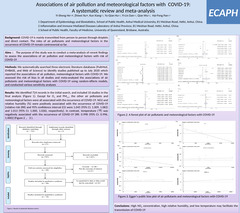Associations of air pollution and meteorological factors with COVID-19: A systematic review and meta-analysis
ID:2
Submission ID:2 View Protection:PUBLIC
Updated Time:2021-06-08 20:38:07
Hits:881
Poster Presentation

Start Time:2021-06-14 08:00 (Australia/Brisbane)
Duration:20min
Session:[ES] E-poster » [SE] E-Poster
Abstract
Background: COVID-19 is mainly transmitted from person to person through droplets and direct contact. The roles of air pollutants and meteorological factors in the occurrence of COVID-19 remain controversial so far.
Objectives: The purpose of the study was to conduct a meta-analysis of recent findings to assess the associations of air pollution and meteorological factors with risk of COVID-19.
Methods: We systematically searched three electronic literature databases (PubMed, EMBASE, and Web of Science) to identify studies published up to July 2020 which reported the associations of air pollution, meteorological factors with COVID-19. We assessed the risk of bias in all studies and meta-analyzed the associations of air pollutants and meteorological factors with COVID-19 using random-effects models, and conducted various sensitivity analyses.
Results: We identified 724 records in the initial search, and included 10 studies in the final analysis. Except for O3 and PM2.5, the other air pollutants and meteorological factors were all associated with the occurrence of COVID-19. NO2 and relative humidity (%) were positively associated with the occurrence of COVID-19 [relative risk (RR) and 95% confidence interval (CI) were 1.045 (95% CI: 1.009, 1.082) and 1.013 (95% CI: 1.000, 1.026), respectively]. In contrast, temperature (℉) was negatively associated with the occurrence of COVID-19 [RR: 0.998 (95% CI: 0.996, 1.000)].
Conclusions: High NO2 concentration, high relative humidity, and low temperature may facilitate the transmission of COVID-19.
Objectives: The purpose of the study was to conduct a meta-analysis of recent findings to assess the associations of air pollution and meteorological factors with risk of COVID-19.
Methods: We systematically searched three electronic literature databases (PubMed, EMBASE, and Web of Science) to identify studies published up to July 2020 which reported the associations of air pollution, meteorological factors with COVID-19. We assessed the risk of bias in all studies and meta-analyzed the associations of air pollutants and meteorological factors with COVID-19 using random-effects models, and conducted various sensitivity analyses.
Results: We identified 724 records in the initial search, and included 10 studies in the final analysis. Except for O3 and PM2.5, the other air pollutants and meteorological factors were all associated with the occurrence of COVID-19. NO2 and relative humidity (%) were positively associated with the occurrence of COVID-19 [relative risk (RR) and 95% confidence interval (CI) were 1.045 (95% CI: 1.009, 1.082) and 1.013 (95% CI: 1.000, 1.026), respectively]. In contrast, temperature (℉) was negatively associated with the occurrence of COVID-19 [RR: 0.998 (95% CI: 0.996, 1.000)].
Conclusions: High NO2 concentration, high relative humidity, and low temperature may facilitate the transmission of COVID-19.
Keywords
Air pollution; meteorological factors; COVID-19
Speaker

Comment submit